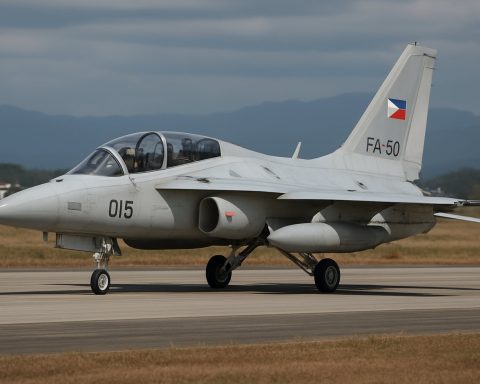- The F-35 Adir jets, key to Israel’s aerial dominance, were temporarily grounded due to a component issue detected by American manufacturers.
- A swift examination and replacement of the faulty component ensured the fleet’s operational capability was unaffected.
- The jets, acquired through a strategic agreement with the U.S., enhance Israel’s air force with stealth and intelligence capabilities.
- Israel’s ambitious procurement plan includes receiving 25 new F-35s, aiming for a total of 75 to strengthen the fleet.
- The F-35 Adirs, having logged 15,000 flight hours, are pivotal in modern warfare with their advanced high-tech features.
- The incident highlights the need for vigilance and proactive maintenance to sustain cutting-edge military technology.
The Israeli Air Force’s pride and joy—its cutting-edge F-35 Adir fighter jets—recently faced a temporary hiccup due to concerns over a critical component. This unexpected pause turned the spotlight onto the advanced fleet acquired through an ambitious procurement plan aimed at bolstering Israel’s strategic edge in the skies.
Imagine a sleek F-35 Adir poised on the runway, its sharp lines cutting a futuristic silhouette against the azure sky—an embodiment of Israel’s aerial supremacy. Yet, as it readied to soar, whispers of caution from its American manufacturers suggested that something was amiss beneath the surface.
Upon receiving alerts from the U.S., Israel grounded its newly-inducted F-35s for meticulous examinations. The fleet, which includes the latest iterations from Lockheed Martin, underwent rigorous scrutiny. Technical teams scanned the aircraft like hawks searching for errant prey. Eventually, the culprit—a single component—was identified and swiftly replaced, clearing the jets for takeoff once more. The swift and efficient response ensured that the operational capability of the Israeli Air Force remained unscathed.
These elite fighters, boasting stealth and intelligence capabilities far surpassing older models, were purchased as part of a strategic move by Israel’s Defense Ministry. Last year’s accord with the U.S. marked the beginning of a new era, with a future vision of 75 F-35s fortifying IAF’s fleet. The agreement entails the delivery of 25 new aircraft, celebrating the synergy between technological innovation and military strategy.
Poised above Middle Eastern skies, the F-35 Adirs have already amassed 15,000 flight hours across various warfronts, their invisible presence a formidable force in modern warfare. These jets are more than just military assets; they are high-tech marvels capable of executing covert operations with an unmatched level of precision.
The temporary grounding, though a reminder of the complexities innate to cutting-edge military technology, underscored a key assurance: vigilance and swift action maintain aerial dominance.
The episode leaves us pondering the intricate balance between technological advancement and operational readiness. As nations lean into advanced warfare technologies, the lesson is clear: readiness doesn’t only rely on having the best equipment, but also on maintaining it at its peak.
The Untold Secrets and Future of Israel’s F-35 Adir Fleet
The F-35 Adir: A Deep Dive into Its Technical Prowess
The F-35 Adir fighter jets represent the pinnacle of modern aerial combat technology, incorporating revolutionary advancements in stealth, sensor fusion, and network-centric warfare. These aircraft transform the tactical landscape by outperforming previous models in agility, range, and versatility.
Key Features of the F-35 Adir:
1. Stealth Capabilities: The F-35’s design minimizes radar cross-section, allowing for operations in hostile environments without detection.
2. Advanced Avionics: The jet’s sensor suite offers real-time data sharing among units, enhancing situational awareness and mission success rates.
3. Versatile Weaponry: With multiple hardpoints, the F-35 can carry a variety of armaments suitable for air-to-air, air-to-ground, and electronic warfare missions.
4. Single-Engine Power: The Pratt & Whitney F135 engine enables unmatched speed and maneuverability with state-of-the-art fuel efficiency.
5. Autonomic Logistics Global Sustainment (ALGS): This system ensures real-time fleet management and predictive maintenance capabilities, keeping the jets combat-ready at all times.
How to Maintain F-35s for Optimal Performance
To maximize operational effectiveness, maintenance protocols for the F-35 Adir must be meticulously followed:
– Routine Inspections: Comprehensive checks on the airframe and components every 300 flight hours.
– Software Updates: Regular updates to mission systems and avionics to stay ahead of evolving threats.
– Component Replacement Schedules: Preemptive swaps of critical parts to prevent potential failures.
Real-World Use Cases and Strategic Importance
The Israeli Air Force (IAF) uses the F-35 Adir for diverse roles, from deterrence to direct engagement. They’ve successfully demonstrated their capabilities in reconnaissance, air dominance, and precision strikes, particularly in volatile regions where timely and accurate interventions are crucial.
Market Forecasts & Industry Trends
The Future of Combat Aviation:
Globally, the demand for fifth-generation fighters like the F-35 is skyrocketing. Analysts predict a steady rise in procurement as nations modernize their air forces to maintain a strategic edge and effectively counter emerging threats.
Industry Trend: Integration of AI and machine learning is expected to further enhance the F-35’s capabilities, facilitating autonomous mission planning and more precise target engagement.
Security & Sustainability Concerns
Though praised for its capabilities, the F-35 program faces criticisms around production delays, software glitches, and spiraling costs. However, continuous improvements and international collaboration aim to optimize production efficiency and lifecycle support.
Addressing Pressing Questions
Why was the Israeli F-35 fleet grounded?
A critical component alert prompted preemptive checks to ensure pilot safety and mission readiness. Such measures highlight the ongoing commitment to maintaining the fleet’s top performance.
What are the long-term expectations for Israel’s F-35 fleet?
With plans to expand to 75 units, Israel aims to solidify its air superiority and establish a robust deterrent force capable of responding swiftly to regional threats.
Quick Tips for Enhanced Air Force Readiness
– Continuous Training: Pilots and technical crews must engage in regular training to keep pace with technological advancements.
– Enhanced Communication Networks: Invest in secure and robust communication links to exploit the F-35’s data-sharing capabilities.
– Strategic Partnerships: Collaborate with allies to leverage shared knowledge and resources for collective defense enhancement.
For more insights into defense technology, visit the official Lockheed Martin website.
In embracing the innovations that the F-35 Adir offers, Israel underscores the importance of balancing cutting-edge technology with rigorous maintenance protocols and strategic foresight. The skies above the Middle East remain a testament to the jet’s silent yet formidable prowess.







